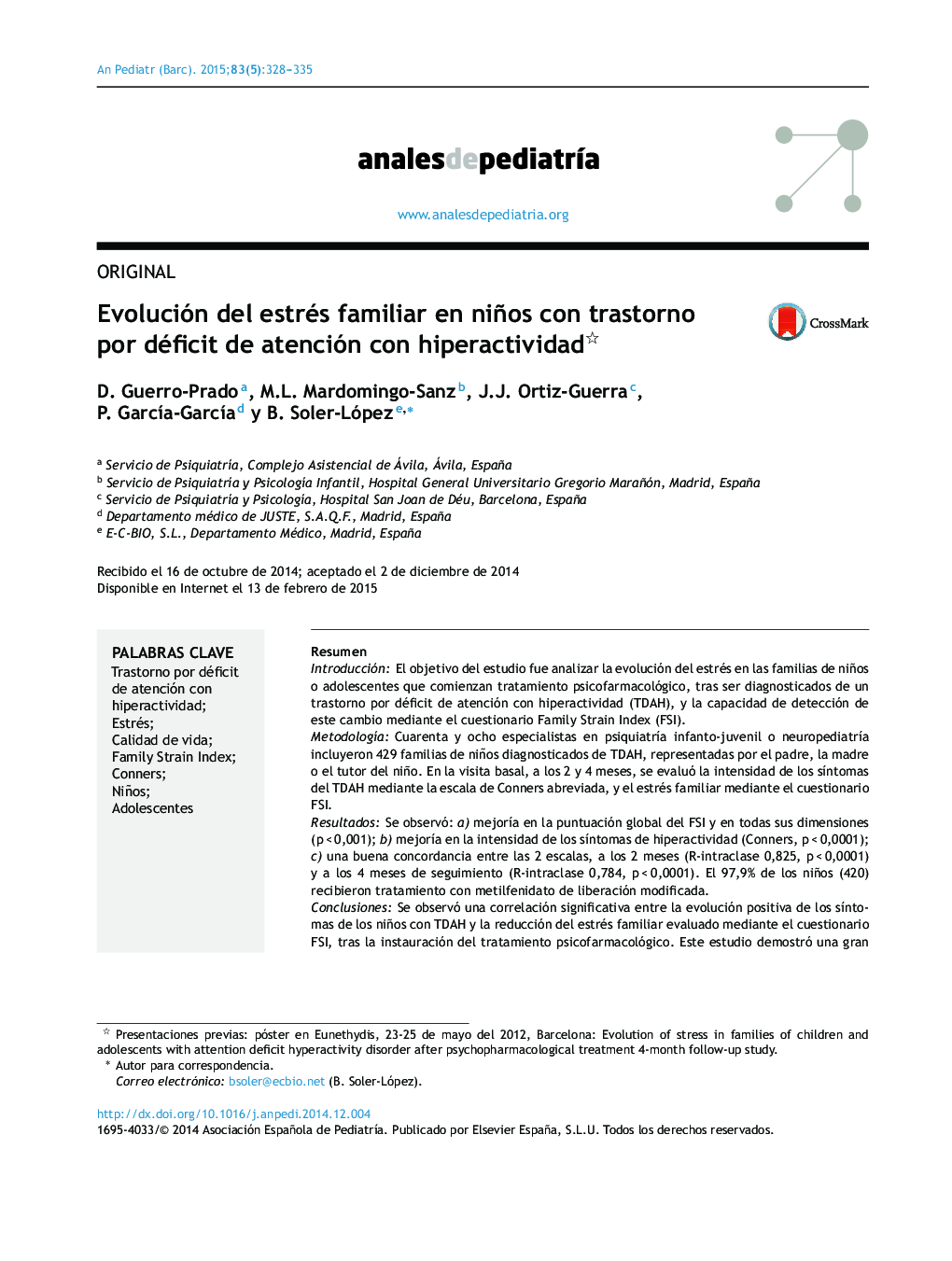| کد مقاله | کد نشریه | سال انتشار | مقاله انگلیسی | نسخه تمام متن |
|---|---|---|---|---|
| 4140950 | 1272309 | 2015 | 8 صفحه PDF | دانلود رایگان |

ResumenIntroducciónEl objetivo del estudio fue analizar la evolución del estrés en las familias de niños o adolescentes que comienzan tratamiento psicofarmacológico, tras ser diagnosticados de un trastorno por déficit de atención con hiperactividad (TDAH), y la capacidad de detección de este cambio mediante el cuestionario Family Strain Index (FSI).MetodologíaCuarenta y ocho especialistas en psiquiatría infanto-juvenil o neuropediatría incluyeron 429 familias de niños diagnosticados de TDAH, representadas por el padre, la madre o el tutor del niño. En la visita basal, a los 2 y 4 meses, se evaluó la intensidad de los síntomas del TDAH mediante la escala de Conners abreviada, y el estrés familiar mediante el cuestionario FSI.ResultadosSe observó: a) mejoría en la puntuación global del FSI y en todas sus dimensiones (p < 0,001); b) mejoría en la intensidad de los síntomas de hiperactividad (Conners, p < 0,0001); c) una buena concordancia entre las 2 escalas, a los 2 meses (R-intraclase 0,825, p < 0,0001) y a los 4 meses de seguimiento (R-intraclase 0,784, p < 0,0001). El 97,9% de los niños (420) recibieron tratamiento con metilfenidato de liberación modificada.ConclusionesSe observó una correlación significativa entre la evolución positiva de los síntomas de los niños con TDAH y la reducción del estrés familiar evaluado mediante el cuestionario FSI, tras la instauración del tratamiento psicofarmacológico. Este estudio demostró una gran sensibilidad al cambio de la situación clínica de los pacientes con TDAH evaluado a través del estrés producido sobre sus familias. Se recomienda el uso de este cuestionario como medida indirecta de la repercusión del trastorno sobre el entorno del niño con TDAH en términos de estrés familiar.
IntroductionThe objective of this study was to assess the evolution of stress in families of children and adolescents who start psychopharmacological treatment after being diagnosed with attention deficit hyperactivity disorder (ADHD), and the ability to detect this change using the FSI (Family Strain Index) questionnaire.MethodologyForty eight (48) specialists in child-adolescent psychiatry or neuropediatrics included 429 families of children diagnosed with ADHD, represented by the father, mother or guardian of the child. In the baseline visit, and at two and four months, the intensity of the symptoms of ADHD was evaluated using the abbreviated Conners scale, and family stress was evaluated using the FSI questionnaire.ResultsThe following was observed: a) an improvement in the overall FSI score and in all its dimensions (P<.001); b) an improvement in the intensity of the symptoms of hyperactivity (Conners, P<.0001); c) good agreement between these two scales at two months (R-intraclass 0.825, P<.0001) and at four months of follow-up (R-intraclass 0.784, P<.0001). Ninety seven point nine percent (97.9%) of the children or adolescents (420) received treatment with modified-release methylphenidate.ConclusionsThere was a significant relationship between the positive evolution of symptoms in children with ADHD and the reduction of family stress, as evaluated by the FSI questionnaire, after starting psychopharmacological treatment. This study showed a great sensitivity to change in the clinical situation of patients with ADHD, evaluated through the stress it produces on its families. It is recommended to use this questionnaire as an indirect measurement of the repercussions of the disorder on the environment of the child with ADHD in terms of family stress.
Journal: Anales de Pediatría - Volume 83, Issue 5, November 2015, Pages 328–335